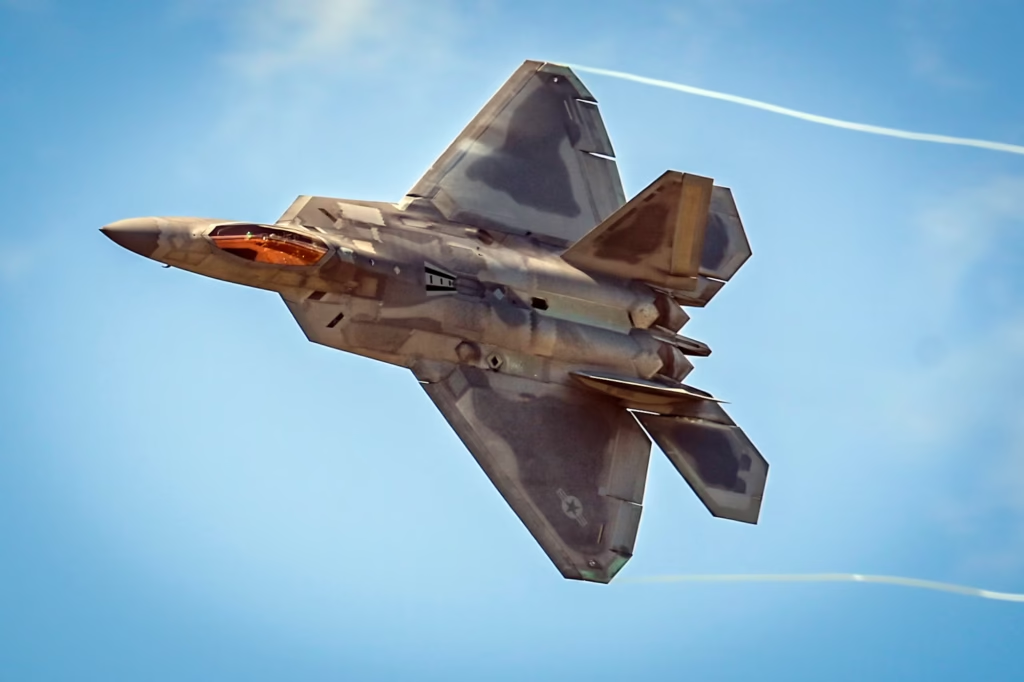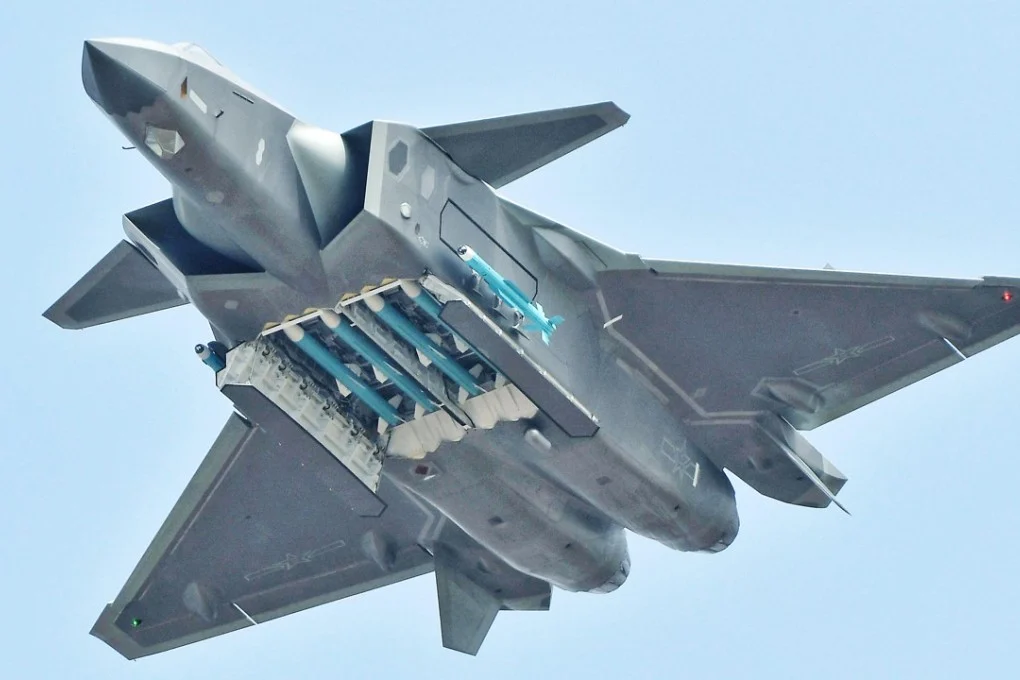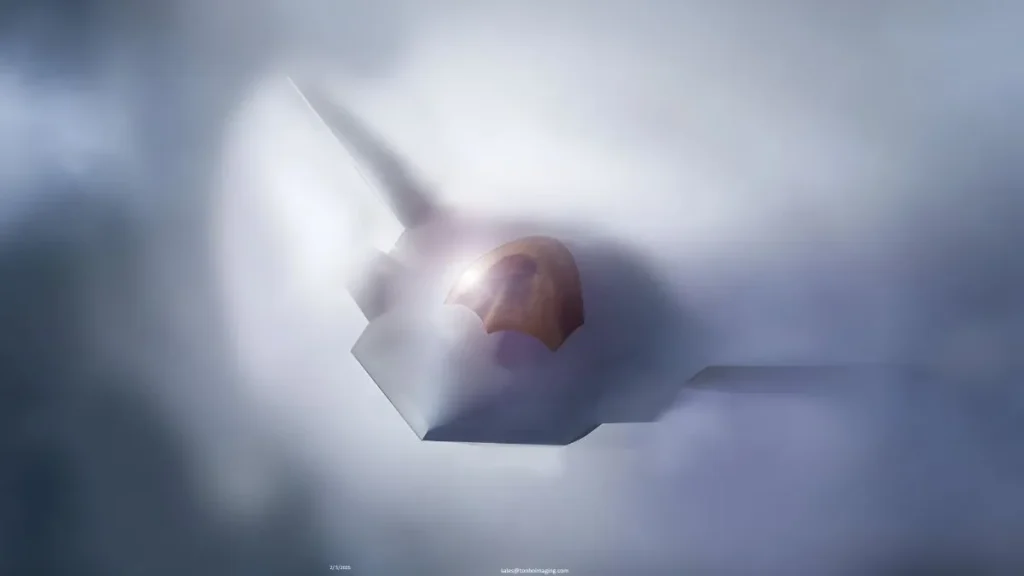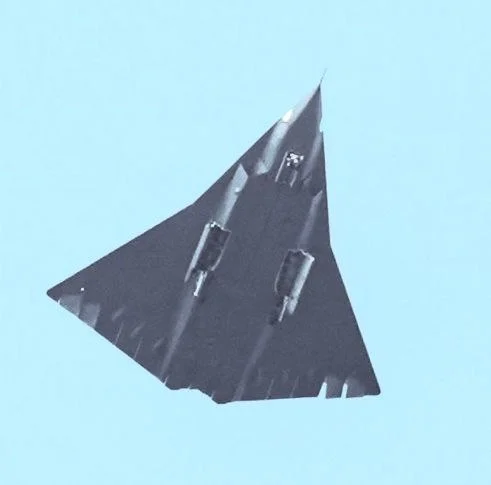The skies of the 21st century are dominated by a new breed of war machines—fifth-generation fighter jets. Leading this charge are two geopolitical giants: America’s F‑22 Raptor and China’s J‑20 Mighty Dragon. At the center of the F‑22 vs J‑20 debate, the platforms symbolize technological advancement with massive strategic ambitions. Though both aircraft showcase cutting-edge technology and stealth, they represent fundamentally different philosophies in aerial warfare.
- Two Fighters, Two Visions
- Comparative Analysis
- Stealth: Proven vs Projected
- Engines: Thrust and Trust
- Sensors and Information Warfare
- Weapons Loadout
- Cockpit Design & Human-Machine Interface (HMI)
- Dominance vs. Density: Aerial Strategy
- F-22 Raptor
- J-20 Mighty Dragon
- Role in Potential Conflicts
- U.S. Precision vs. Chinese Mass Strategy
- The Cost Behind Fifth-Gen Air Power
- Sixth-Generation Futures
- Conclusion
- F‑22 vs J‑20: Top FAQs on the Fifth-Gen Fighter Rivalry
Two Fighters, Two Visions
The F-22 Raptor, developed by Lockheed Martin, is a product of Cold War urgency, designed for total air superiority. Its journey began with the Advanced Tactical Fighter (ATF) program in the late 1980s and entered service in 2005.
The J-20 Mighty Dragon, crafted by Chengdu Aerospace Corporation, reflects China’s 21st-century doctrine of Anti-Access/Area Denial (A2/AD) and long-range interception. Its maiden flight was in 2011, entering service by 2017.
F‑22 vs J‑20 histories reflect broader national military-industrial strategies—American focus on fewer, high-end systems versus Chinese scalable development and regional projection strategy.
Comparative Analysis
| Feature | F-22 Raptor | J-20 Mighty Dragon |
|---|---|---|
| Top Speed | Mach 2.25 | Mach 2.0 |
| Supercruise | Yes (Mach 1.8) | No (planned with WS-15) |
| Radar | AN/APG-77 AESA | KLJ-5 AESA (speculated) |
| Stealth | All-aspect | Mostly frontal |
| Engine | F119-PW-100 | WS-10C (WS-15 in testing) |
| Combat Experience | Proven (Iraq, Syria, Libya) | None |
| Cost per Hour | ~$70,000/hour | ~$40,000/hour (estimated) |
| Role | Long-Range Interceptor Stealth | Long-Range Interceptor / Stealth |
| Operational Since | 2005 | 2017 |
Stealth: Proven vs Projected
The F-22’s stealth is legendary—thanks to its internal weapon bays, radar-absorbing materials, and stealth-optimized shape. In contrast, the J-20’s canard design and exposed engine nozzles compromise its stealth, especially from the sides and rear.
Engines: Thrust and Trust
F-22’s F119 engine delivers supercruise, thrust vectoring, and 35,000 lbs of reliable power. It has a strong dependency record and has been tested in varied climatic and combat situations.
While the J-20’s WS-10C lacks comparable thrust and supercruise. Its future WS-15 engine remains in development, facing reliability issues. The WS-15 engine, until tested in dynamic conditions and fully operational, would keep the J-20 agile but limited in range. The F-22’s propulsion system provides an
advantage that translates directly into better maneuvering and mission endurance capability.
Sensors and Information Warfare
The F-22 excels in sensor fusion, combining radar, infrared, and EW data for unmatched situational awareness. The F-22 features the advanced AN/APG-77 AESA radar, state-of-the-art electronic warfare
systems, and wide sensor fusion. It even integrates radar, IR, and threat data into a single picture. It uses military-grade encryption data links like MADL and IFDL for uninterrupted, seamless coordination with other platforms.
The J-20 is expected to incorporate the use of KLJ-5 AESA radar and IRST sensors. Even though their data-link capabilities are quite well established. While it may have a comparable detection range, sensor fusion and real-time battlefield integration appear less advanced. The J-20 is improving with AESA radars and IRST, but battlefield-tested network warfare remains limited. Early detection and coordination are crucial and key in modern air combat, which gives the F-22 a time-sensitive advantage.
Weapons Loadout

F-22 Raptor
Air-to-Air –
- 6× AIM-120D AMRAAM (160+ km, dual-pulse motor, data-link guided)
- 2× AIM-9X Block II (HOBS capability, thrust-vectoring seeker)
Air-to-Ground (Stealth gets compromised):
- JDAM (GBU-32, GBU-39 SDB) with the use of external pylons.
Future Integration:
- Hypersonic missile trials are currently ongoing and being tested heavily, with the potential for the AIM-260 JATM (Joint Advanced Tactical Missile).
J-20: The Mighty Dragon

Air-to-Air:
- 4–6× PL-15 (It is estimated to have a 200–300 km range with AESA guidance)
- 2× PL-10 IR missiles (HMD-cued, agile engagements)
Long-Range Offensive: Speculative PL-21 that is designed for high-value targets (AWACS, tankers), ramjet, or dual-pulse powered.
Modularity: Internal rotary launchers, as per sources reported, are probably under massive testing for faster and swifter multi-target engagement and acquisition.
F-22 load-outs emphasize first-shot kill via agility and stealth; J-20 favors engagement depth and standoff distance, consistent with A2/AD (Anti-Access/Area Denial) doctrine. The Raptor prioritizes more survivability and reduced pilot interference through minimal cognitive burden. Whereas, the Dragon appears to prioritize more highly automated and encrypted technologies, implying a potential transition soon to unmanned or optionally manned roles.
Operational Relevance: The F‑22 vs J‑20 comparison shows the F‑22 excels in passive detection as well as in stealth synergy. Compared to the J-20, designers more likely designed it for offensive EW in contested electromagnetic environments (EME), particularly in Taiwan and South China Sea scenarios.
Cockpit Design & Human-Machine Interface (HMI)
| Capability Aspect | F-22 Raptor | J-20 Mighty Dragon |
|---|---|---|
| Display Suite | Triple MFDs, wide-angle HUD | Glass cockpit with touchscreen MFDs |
| Controls | HOTAS (Hands-on Throttle and Stick), voice input | Believed HMD-enabled interface |
| Sensor Fusion | High integration: radar, EW, IFF, IRST | AI-enabled decision aids (unconfirmed) |
| Pilot Workload Mitigation | FLCS (Fly-by-Light), AI threat prioritization | Automated threat analysis via neural algorithms |
The above F‑22 vs J‑20 data comparison helps to come to an inference that the F‑22 prioritizes more on the control and situational awareness of the pilot by incorporating mature sensor fusion and manual interfaces. While its adversary, the J‑20, emphasizes heavy automation and AI-driven threat analysis that implies a gradual shift towards semi-autonomous combat operations. This contrast between the two platforms highlights the focus of the U.S. on cognitive edge vs. China’s push for scalable, tech-assisted efficiency.
In short, the F‑22 vs J‑20 distinction lies in cognitive philosophy—the F‑22 offers the pilot maximum cognitive control with mature fusion interfaces. The J‑20 is more automation-heavy, suggesting future potential for unmanned roles or AI-driven combat assistance.
Dominance vs. Density: Aerial Strategy
F-22 Raptor
- Total Units Produced: Total units are around 186 out of which 120 are operational. The program got capped due to post-Cold War budget cuts and perceived threat reduction.
- Design Priority: Built for absolute air dominance—high agility, supercruise, stealth shaping, and electronic warfare (EW) integration. Stealth is optimized for a reduced frontal cross-section of approximately 0.0001 m² RCS.
- Operational Use: More effective in multiplying roles and also has had no combat loss in over 15 years. Ideal for small-scale, high-impact missions requiring rapid escalation dominance.
J-20 Mighty Dragon
- Estimated Fleet Size: The fleet size is reported to be somewhere around 250–300+ units (as of 2025); production continues. The PLAAF aims for fleet sizes sufficient for theater saturation.
- Design Doctrine: Emphasizes long-range BVR (beyond visual range) combat, network integration, and radar evasion from multiple angles. Sacrifices some agility for payload, fuel, and avionics size.
- Manufacturing Edge: Serial production using modular airframe components and local supply chains. Rapid induction into multiple theaters – Eastern and Western Commands.
Role in Potential Conflicts
In a F-22 vs J-20 scenario, whether in Taiwan or the South China Sea, China would use the J-20 to deter and launch a counter onto U.S. assets and assert air dominance. The J-20 would engage in long-range strikes, target AWACS, and support A2/AD zones. The U.S. would deploy F-22s to gain air superiority, defend strike packages, and precisely eliminate key enemy fighters and radars. Forward bases enable rapid deployment, making the F-22 ideal for defending the Pacific region. The J-20 could only be effective in its own airspace or with strong IADS support but would expose itself as a vulnerable target in open maneuver dogfight warfare. The F-22’s versatility across mission types makes it more flexible and adaptable.
The J-20 serves functional and symbolic purposes. Its imposing size and aggressive media portrayal make it a psychological and combat weapon. The Dragon plays a critical role in national defense parades and propaganda-based films, symbolizing technological advancement. However, gaps in performance and operational secrecy raise serious questions behind the image. In contrast, the F-22 was built quietly and solely for warfighting, without export or intimidation goals. Its operational history shows function over image. While the J-20 may deter, the F-22 delivers proven battlefield value.
U.S. Precision vs. Chinese Mass Strategy
| Capability Aspect | F-22 Raptor | J-20 Mighty Dragon |
|---|---|---|
| Core Philosophy | Elite precision over mass | Strategic mass to overwhelm and deny airspace |
| Doctrine Fit | Expeditionary, rapid strike, air superiority | A2/AD posture, homeland defense, regional power focus |
| Production Goal | Quality-controlled innovation, selective application | High-volume saturation, distributed deterrence |
| Force Projection | Global (NATO interoperability, rapid deployment) | Regional (Taiwan Strait, South China Sea, India front) |
| Risks | Fleet aging, low density per theatre | Limited individual aircraft survivability |
The Cost Behind Fifth-Gen Air Power
F-22
The flight hour cost is almost around $70K+ (USD). MTBF (Mean Time Between Failure): Approximately 1.7 hours for stealth coatings and radar systems.
Key Challenges: Proprietary materials make field-level maintenance even more difficult. Depot-level support is regularly required for LO repairs of the body skin.
Upgrades: Post 2020, non-scalable architectures limit the sensors and communication upgrades.
J-20
Design Philosophy: Modular construction for rapid part replacement. Advantages Claimed by PLA Sources:
- Reduced maintenance cycles.
- Line-replaceable units (LRUs) for forward-deployed sustainment.
Engine Evolution: The transition from Russian AL-31F to indigenous WS-10C. Also, they are planning to further upgrade it to WS-15 in the coming future. For deployment, the WS-15 is being tested for true supercruise.
Strategic Implication: The J-20 may achieve a faster sortie generation rate in a prolonged regional conflict; the F-22 remains constrained by aging logistics and limited upgrade bandwidth.
The F-22 program cost the U.S. around $67 billion with a limited production unit size of 187 aircraft. The high cost per unit (~$150M) was due to its cutting-edge tech and export ban. The J-20’s development cost is unknown but believed to be lower due to industrial scale and government subsidies. The estimated cost per aircraft is ~$100M, making it more scalable. Maintenance for the F-22 remains expensive, driven by stealth coating upkeep and supply chain specialization. J-20 maintenance costs are unclear but presumed lower due to domestic sourcing. The F-22 is expensive but refined; the J-20 is cost-efficient but less proven.
- Western analysts see the F-22 as unmatched in air-to-air combat.
- Indian analysts praise J-20’s growth but question stealth and engines.
- Russian and Chinese experts highlight its symbolic and deterrent role.
Sixth-Generation Futures


- USA NGAD: “System of systems” with adaptive engines, loyal wingmen, and DEWs.
- China’s Shenyang Project: Focused on AI, drone swarms, quantum radar, and photonic warfare.
Conclusion
The Raptor remains the high standard in air superiority. It builds confidence in avionics integration and network warfare. The Mighty Dragon stands as a credible rising force reflecting the boom in Chinese aerospace progress. However, it faces engine issues, lacks combat history, and shows unverified integration claims. The F-22 Raptor embodies high capability, excels in stealth, agility, and air dominance, but faces limitations from high maintenance and small fleet size. Its design prioritizes cognitive superiority and precision strike, making it ideal for rapid escalation scenarios. In contrast, the J-20 Mighty Dragon reflects a focus on scalable production, long-range engagement, and regional saturation.
Battle-hardened combat records support the F-22, despite its high cost. In comparison, the J-20 offers scale but lacks complete validation. In close dogfights, the F-22 likely dominates due to better sensors, stealth, pilot interface, and combat experience. Though combat rarely proves it, the J-20 benefits from modular logistics, automation, and rapid deployment potential.
The F‑22 vs J‑20 comparison shows that battle-hardened records still support the F‑22, even with its high cost. Compared to the J‑20, it offers scale but lacks complete validation. In a close dogfight, the F‑22 likely dominates due to better advanced sensors, stealth, pilot interface, and battlefield experience. Though combat hardly proves it, the J‑20 benefits from modular logistics, automation, and rapid deployment potential.
F‑22 vs J‑20: Top FAQs on the Fifth-Gen Fighter Rivalry
1. What is the difference between the F‑22 and J‑20 fighter jets?
The F‑22 Raptor is a U.S. fifth-generation air superiority fighter known for stealth, agility, and proven combat capability. The J‑20 Mighty Dragon, developed by China, focuses on long-range strike, automation, and symbolic deterrence, but lacks battlefield validation.
2. Is the F‑22 better than the J‑20 in air combat?
In close-range dogfight scenarios, the F‑22 holds an advantage due to its advanced stealth, pilot interface, sensor fusion, and combat experience. The J‑20, while capable, remains largely untested in real combat.
3. Can the J‑20 challenge the F‑22 in modern warfare?
The J‑20 poses a growing challenge with its automation, radar systems, and strategic positioning in the Indo-Pacific. However, the F‑22 offers greater flexibility, sensor dominance, and operational history that still gives it the edge.
4. Why is the F‑22 not exported like the J‑20?
The F‑22 was built strictly for U.S. military use with no export version, prioritizing secrecy and battlefield superiority. The J‑20, while also not widely exported, plays a larger symbolic role in China’s defense image.
5. Which countries operate the F‑22 and J‑20 jets?
The F‑22 Raptor is exclusively operated by the United States. The J‑20 is currently fielded only by China’s People’s Liberation Army Air Force (PLAAF), with no foreign users yet.




